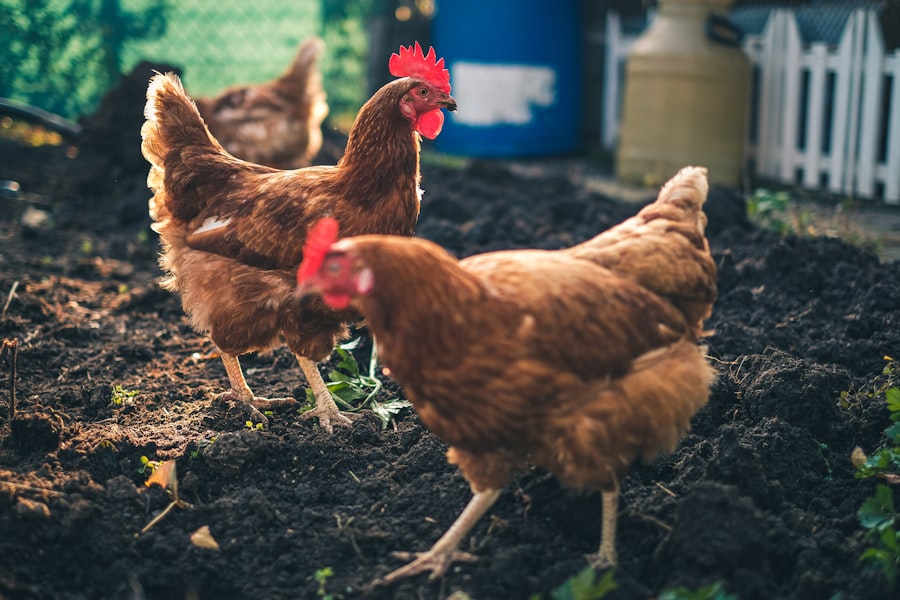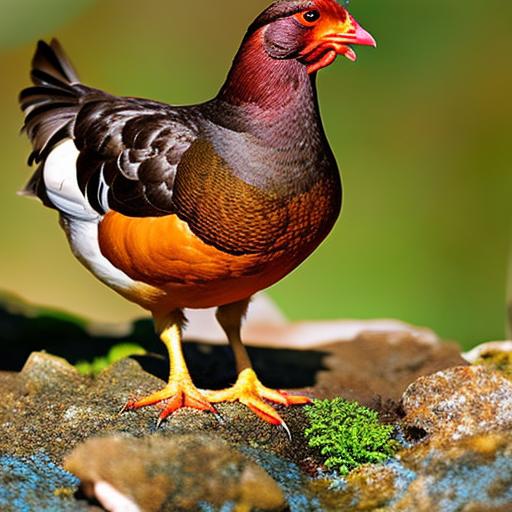Bantams and standard chickens are both popular choices for backyard poultry enthusiasts. Bantams are smaller versions of standard chickens, often weighing less than half the size of their larger counterparts. They come in a variety of breeds, each with its own unique characteristics and appearances. Standard chickens, on the other hand, are the typical-sized chickens that most people are familiar with.
People choose to keep bantams and standard chickens for various reasons. Some keep them as pets, enjoying their company and unique personalities. Others keep them for egg production, as both bantams and standard chickens can lay eggs. Bantam eggs are smaller in size compared to standard chicken eggs, but they can still be used for cooking and baking.
Key Takeaways
- Bantams are smaller versions of standard chickens, with unique characteristics and traits.
- The main differences between bantams and standard chickens are their size, temperament, and egg-laying abilities.
- Before keeping bantams with standard chickens, consider factors such as breed compatibility, space requirements, and potential health risks.
- Advantages of keeping bantams and standard chickens together include increased diversity, reduced boredom, and potential for crossbreeding.
- Disadvantages of keeping bantams and standard chickens together include potential for aggression, competition for resources, and increased risk of disease transmission.
Differences Between Bantams and Standard Chickens
One of the most obvious differences between bantams and standard chickens is their size. Bantams are significantly smaller than standard chickens, with some breeds weighing as little as 1-2 pounds. Standard chickens, on the other hand, can weigh anywhere from 5-10 pounds or more, depending on the breed.
Temperament is another area where bantams and standard chickens differ. Bantams are known for being more feisty and independent compared to their larger counterparts. They can be more flighty and prone to aggression, especially if they feel threatened. Standard chickens, on the other hand, tend to be more docile and easygoing.
In terms of egg production, there can be differences between bantams and standard chickens. While both can lay eggs, bantams tend to lay smaller eggs and may not produce as consistently as standard chickens. However, this can vary depending on the breed and individual bird.
Factors to Consider Before Keeping Bantams with Standard Chickens
Before deciding to keep bantams with standard chickens, there are several factors to consider. One important factor is space requirements. Bantams require less space compared to standard chickens due to their smaller size. However, it is still important to provide enough space for both breeds to roam and forage comfortably.
Compatibility of breeds is another consideration. Some breeds of bantams and standard chickens may get along better than others. It is important to research the specific breeds you are interested in and their compatibility with each other. Some breeds may be more prone to bullying or aggression, which can cause stress and harm to the birds.
Potential for bullying or aggression is another factor to consider. Bantams, due to their smaller size, may be more vulnerable to bullying from larger standard chickens. It is important to monitor the interactions between the birds and provide enough space and resources to minimize potential conflicts.
Advantages of Keeping Bantams and Standard Chickens Together
There are several advantages to keeping bantams and standard chickens together. One advantage is the variety of egg sizes and colors. By keeping both breeds, you can have a range of egg sizes, from small bantam eggs to larger standard chicken eggs. Additionally, different breeds of bantams and standard chickens can lay eggs in various colors, adding visual interest to your egg collection.
Another advantage is the unique personalities and behaviors of both bantams and standard chickens. Bantams are known for their feisty and independent nature, while standard chickens tend to be more docile. This mix of personalities can make for an interesting and entertaining flock.
Keeping bantams with standard chickens can also potentially reduce feed costs. Bantams require less feed compared to standard chickens due to their smaller size. By keeping a mix of both breeds, you can adjust your feeding amounts accordingly, potentially saving money on feed expenses.
Disadvantages of Keeping Bantams and Standard Chickens Together
While there are advantages to keeping bantams and standard chickens together, there are also some disadvantages to consider. One disadvantage is the increased risk of disease transmission. When different breeds are kept together, there is a higher chance of disease spreading between them. It is important to practice good biosecurity measures and monitor the health of your flock regularly.
Another potential disadvantage is the potential for bullying or aggression. Bantams, due to their smaller size, may be more vulnerable to bullying from larger standard chickens. This can lead to stress and harm to the birds. It is important to provide enough space and resources to minimize potential conflicts.
Different dietary needs can also be a disadvantage when keeping bantams and standard chickens together. Bantams may require a different type or amount of feed compared to standard chickens. It is important to ensure that both breeds are receiving the appropriate nutrition for their specific needs.
Housing Requirements for Bantams and Standard Chickens

When keeping bantams and standard chickens together, it is important to consider their housing requirements. The coop size and design should be suitable for both breeds. Bantams require less space compared to standard chickens, but it is still important to provide enough room for both breeds to move around comfortably.
Nesting box requirements should also be considered. Bantams may prefer smaller nesting boxes compared to standard chickens. Providing a mix of nesting box sizes can accommodate the preferences of both breeds.
Roosting preferences should also be taken into account. Bantams may prefer lower roosts compared to standard chickens. Providing roosts at different heights can accommodate the preferences of both breeds.
Feeding Requirements for Bantams and Standard Chickens
Feeding requirements for bantams and standard chickens can vary due to their different sizes and dietary needs. Bantams require less feed compared to standard chickens due to their smaller size. It is important to provide a balanced diet that meets the nutritional needs of both breeds.
Feeding schedules and amounts may need to be adjusted to accommodate the different needs of bantams and standard chickens. It is important to monitor the body condition of each bird and adjust feeding amounts accordingly.
Supplemental feeding considerations should also be taken into account. Bantams may require additional supplements or treats to meet their specific nutritional needs. It is important to provide a variety of feed options to ensure that both breeds are receiving the appropriate nutrition.
Health Concerns for Bantams and Standard Chickens
Both bantams and standard chickens can be susceptible to various health issues. Common health issues for both breeds include respiratory infections, parasites, and egg-related problems. It is important to monitor the health of your flock regularly and seek veterinary care if necessary.
Bantams may have some unique health concerns compared to standard chickens. Due to their smaller size, they may be more prone to injuries or predation. It is important to provide a safe and secure environment for both breeds to minimize these risks.
Preventative measures should be taken to keep both bantams and standard chickens healthy. This includes practicing good biosecurity measures, providing a clean and sanitary environment, and ensuring that the birds have access to fresh water and nutritious feed.
Tips for Introducing Bantams to a Flock of Standard Chickens
When introducing bantams to a flock of standard chickens, it is important to follow a gradual introduction process. This involves keeping the new birds separate from the existing flock initially and gradually introducing them over a period of time. This allows the birds to become familiar with each other’s presence without causing undue stress or aggression.
Supervision during initial interactions is crucial to ensure that there are no conflicts or bullying behaviors. It is important to monitor the interactions between the birds closely and intervene if necessary.
Separation options should be available in case the introduction process does not go smoothly. This can include providing separate areas or enclosures for the bantams and standard chickens until they are fully integrated.
Can You Keep Bantams with Standard Chickens?
In conclusion, keeping bantams with standard chickens can be a rewarding experience, but it requires careful consideration and planning. There are advantages to keeping both breeds together, such as a variety of egg sizes and colors, unique personalities and behaviors, and potential cost savings on feed. However, there are also disadvantages to consider, such as increased disease transmission risk, potential for bullying or aggression, and different dietary needs.
Personal experience with keeping bantams and standard chickens together can vary depending on the specific breeds and individual birds involved. It is important to research the specific breeds you are interested in and their compatibility with each other. It is also important to provide a suitable housing environment and meet the dietary needs of both breeds.
Before making a decision to keep bantams with standard chickens, it is encouraged to consider the benefits and challenges outlined in this article. By doing so, you can make an informed decision that is best for you and your flock.
If you’re wondering whether you can keep bantams with standard chickens, you may also be interested in learning about the compatibility of geese and chicken feed. Poultry Wizard has an informative article on this topic, which explores whether geese can eat chicken feed and provides insights into their dietary needs. Understanding the dynamics of different poultry species can help you create a harmonious and well-balanced flock. To read more about it, check out the article here. Additionally, if you’re looking for guidance on where to place your chicken coop, Poultry Wizard offers valuable tips and considerations in their article here. Lastly, if you’re interested in breeding turkeys and want to know more about their mating season, Poultry Wizard has an insightful article that covers this topic in detail. You can find it here.
FAQs
What are bantam chickens?
Bantam chickens are small breeds of chickens that are about one-third to one-half the size of standard chickens. They are popular for their ornamental value and are often kept as pets.
What are standard chickens?
Standard chickens are the regular-sized breeds of chickens that are commonly raised for meat and egg production. They are larger than bantam chickens and come in various breeds.
Can bantams and standard chickens be kept together?
Yes, bantams and standard chickens can be kept together. However, it is important to introduce them slowly and monitor their interactions to ensure that the bantams are not bullied or injured by the larger birds.
What are the benefits of keeping bantams with standard chickens?
Keeping bantams with standard chickens can provide a diverse flock with different sizes, colors, and personalities. It can also help to reduce boredom and aggression among the birds.
What are the potential problems of keeping bantams with standard chickens?
The main potential problem of keeping bantams with standard chickens is the risk of bullying and injury to the smaller birds. Bantams may also have difficulty competing for food and water with larger birds.
How can I introduce bantams to my existing flock of standard chickens?
It is best to introduce bantams to the flock gradually, by keeping them in a separate enclosure within the same area for a few days. This allows the birds to get used to each other’s presence without direct contact. After a few days, you can allow them to interact under supervision and gradually increase their time together.
Meet Walter, the feathered-friend fanatic of Florida! Nestled in the sunshine state, Walter struts through life with his feathered companions, clucking his way to happiness. With a coop that’s fancier than a five-star hotel, he’s the Don Juan of the chicken world. When he’s not teaching his hens to do the cha-cha, you’ll find him in a heated debate with his prized rooster, Sir Clucks-a-Lot. Walter’s poultry passion is no yolk; he’s the sunny-side-up guy you never knew you needed in your flock of friends!







